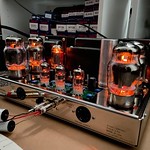Kinski wrote:Ok, thanks so much for all the help so far. I have a new question regarding the ST-70.
Sadly, it seems one of the original Sylvania EL34 tubes is bad. It tends to red-plate BADLY if bumped in just the right way. And makes loud short staticky sounds when tapped. These issues follow the tube when swapped to a different location.
So it looks like it has to go. I should probably take out the other EL34 in that channel and put in a matched pair. If so, I have a matched pair of lightly used SED Winged C EL34 that need a home.
Also, I'd really love to keep the other original Sylvania pair on the other channel. Is there any reason I should not do this? I guess technically the subtle differences between the two tube brands would play out in their own channel, but I think I can live with that.
Thoughts on this?
YIKES!!
Minor Rant Warning:
a) Turn off and unplug the amp and allow it to cool for 24 hours.
b) Obtain a couple of dental-picks, some Q-Tips, extremely high-proof *isopropyl alcohol* and some old fashioned *round* toothpicks.
c) Find a workbench (or kitchen table) with excellent, shadow-free lighting.
d) Remove all tubes and mark their locations on the amp (and the tubes).
e) Remove the cage and bottom plate.
Now, working over a towel, thick rag or similar, you are going to clean and tension all the tube sockets. First rinse them down with the Alcohol (91% minimum, 100% if you can find it). I use a rechargeable compressed air spray can so as to get some force behind it when rinsing. The amp is unplugged and cold, you are working over a towel, so unless you are a smoker, there is little danger here.
Then, using the round tooth-picks (which you have soaking in alcohol), you will lightly clean out the tube sockets. The wood will burnish to a small degree and do no damage and leave no metal shavings behind. If you happen to have burnishing files (a specialty Jeweler's item) you may use them, carefully. On the 9-pin sockets, do not push in too hard. Be VERY careful.
Then, using the dental picks, you will carefully tighten each socket by pulling the individual contacts in each individual pin socket back towards the center. Carefully, slowly, take your time. Keep in mind that these sockets are many years old, made from tin-plated bronze, and have been thoroughly annealed over the years. They are *SOFT* and *LOOSE*.
Rinse again with alcohol. Use the Q-Tips on the bottom and see if any skunge comes off. If so, keep rinsing until it comes clean.
Then using a coarse Scotch-Brite pad, clean off the tube pins, also using alcohol. Check for any loose bases. If there are any, DO NOT use super-glue to repair them. The stuff dries so hard that it has been known to cause the glass to fracture from thermal stress. Use a hard temperature-resistant epoxy such as JB-Weld or similar in small, careful amounts.
On the Wonky tube, touch up each pin with the soldering iron and add a bit of solder. Hold the tube upside down when doing this and flow a *small* amount of solder into each pin. We are looking to correct any separated leads.
When everything is nice and clean - and tight - re-assemble and reinstall the tubes. Bias as directed. I suspect that the red-plate issue will have gone away.
These are very basic maintenance items on any piece of tube equipment new to the stable. Kinda-sorta like isolating a new kitten or puppy until it has had its shots and is wormed. I do this stuff on anything new even before I apply power for the first time. Having done it so often, it would take me less than an hour on the 70, even if truly filthy.
While you are there, also check every wire connection (both ends) on the tube sockets. Use the dental picks to give each connection a bit of a tug. Back when old-fashioned clamp-type one-size-fits-all wire strippers were used, wires got nicked - and nicked wires will crack at the nick causing frustrating and often invisible intermittents. And, examine the traces on the circuit boards very carefully. Sometimes thermal stresses cause the traces to crack. Reflow any that look suspicious, and use a strand of fine wire over the suspected gap as "rebar".
Above all, enjoy!
Last edited by Peter W. on Wed Sep 20, 2017 5:03 pm; edited 1 time in total (Reason for editing : Added advice on checking connections and traces.)



